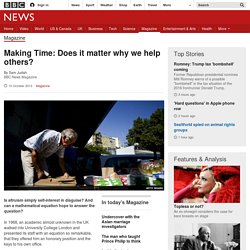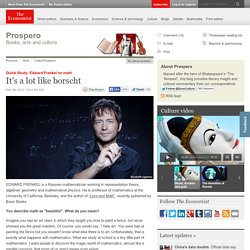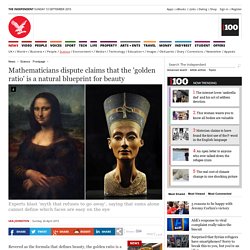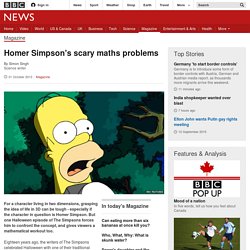

The math behind Beethoven’s music (in TED-Ed GIFs) How is it that Beethoven, who is celebrated as one of the most significant composers of all time, wrote many of his most beloved songs while going deaf?

As Natalya St. Clair explains below, the answer lies in the math behind Beethoven’s music. The standard piano octave consists of 13 keys, each separated by a half step. A standard major or minor scale uses 8 of these keys with 5 whole step intervals and 2 half step ones. Using the “Moonlight Sonata,” we can begin to understand the way Beethoven was able to convey emotion and creativity using the certainty of mathematics. The world’s largest prime number has 22,338,618 digits. Here’s why you should care. Image by Eyematrix/Thinkstock Earlier this week, BBC News reported an important mathematical finding, sharing the news under the headline “Largest Known Prime Number Discovered in Missouri.”

That phrasing makes it sound a bit like this new prime number—it’s 274,207,281-1, by the way—was found in the middle of some road, underneath a street lamp. That’s actually not a bad way to think about it. We know about this enormous prime number thanks to the Great Internet Mersenne Prime Search. The Mersenne hunt, known as GIMPS, is a large distributed computing project in which volunteers run software to search for prime numbers.
A prime number is a whole number whose only factors are 1 and itself. How Big Is Infinity? The Math Mystery: Mathematics in Nature and Universe - Documentary. 1,2,3,4,5,6,7,8,9,10,11,12,13,14,15,16,17,18,19,20,21,22,23,24,25,26,27,28,29,30,31,32,33,34,35... Philosophy of Numbers - Numberphile. Overthehill. Maybe not, but the idea lingers due to an abundance of young talent By LILA GUTERMAN While swimming laps, Pavel Etingof thinks about math.

The crowds and noise on a city bus do little to distract Allen Knutson from the equations he scribbles on a notepad he keeps handy. Francis E. Su gave up his songwriting hobby to spend more time on his proofs. The constant devotion of these and other mathematicians to their work has allowed them to produce seminal proofs and impressive results that have won them high praise early in their careers -- all are under 35.
But many of them have something other than math to worry about. Mr. Examining the foundations of mathematics v2. Are Mathematicians Past Their Prime at 35. The Infinite Hotel Paradox - Jeff Dekofsky. Making Time: Does it matter why we help others? Is altruism simply self-interest in disguise?

And can a mathematical equation hope to answer the question? In 1968, an academic almost unknown in the UK walked into University College London and presented its staff with an equation so remarkable, that they offered him an honorary position and the keys to his own office. His name was George Price, and his equation addressed a problem that has vexed scientists since Charles Darwin published On The Origin of Species more than a century earlier. Explicit cookie consent. EDWARD FRENKEL is a Russian mathematician working in representation theory, algebraic geometry and mathematical physics.

He is professor of mathematics at the University of California, Berkeley, and the author of “Love and Math”, recently published by Basic Books. You describe math as "beautiful". What do you mean? Imagine you had an art class in which they taught you how to paint a fence, but never showed you the great masters.
Of course, you would say; ‘I hate art.' How did you discover it? When I was growing up near Moscow I thought mathematics was the most boring and irrelevant subject, but I was fascinated with quantum physics and elementary particles. Can complex mathematical ideas be explained to someone who is not a mathematician? Yes. Mathematicians dispute claims that the 'golden ratio' is a natural blueprint for beauty - Science - News - The Independent. But the widespread belief that the golden ratio is the natural blueprint for beauty is pseudo-scientific “hocus-pocus” and a “myth that refuses to go away”, according to leading mathematicians.

The issue has flared up again, after one of the United States’s leading scientific organisations, the Smithsonian, promoted highly contentious claims about the ratio at the National Math Festival in Washington DC earlier this month. Theories that the Parthenon in Athens, pictured, and Great Pyramid in Egypt were built according to the golden ratio have also been disproved (EPA) Eve Torrence, a professor at Randolph–Macon College in Virginia, said she was appalled to find a Smithsonian-branded stall which claimed the golden ratio is found in the human body.
It offered visitors the chance to put their head through an oval, allegedly to demonstrate whether their face was in accordance with what is also known as the “divine proportion”. Loading gallery. Homer Simpson's scary maths problems. For a character living in two dimensions, grasping the idea of life in 3D can be tough - especially if the character in question is Homer Simpson.

But one Halloween episode of The Simpsons forces him to confront the concept, and gives viewers a mathematical workout too. Ethiopian mathematics. Mathematical equations that changed the world. The Great Math Mystery. Viewpoint on 'Is there something myster... In one sense, of course, there’s less mystery in math than there is in any other human endeavor.

In math we can really understand things, in a deeper way than we ever understand anything else. (When I was younger, I used to reassure myself during suspense movies by silently reciting the proof of some theorem: here, at least, was a certainty that the movie couldn’t touch.) So how is it that many people, including mathematicians, do feel there’s something “mysterious” about this least mysterious of subjects? What do they mean?
There are certainly mysteries within math. Yet, for reasons that apply to many other unsolved problems, it’s debatable whether to call this a “mystery.” Mathematical equations that changed the world. Is it possible to just click with someone? ‘Whether the computer reckons you’re a love match or not isn’t something that anyone should take seriously’ I’ve occasionally wondered whether the secret to love is mathematics, and I’m not the only one.

Mathematics is full of perky ideas about matching or sorting that have a veneer of romantic promise. But for all their beauty and cleverness, one often feels that such ideas are a far better introduction to mathematics than they are to dating and mating. Consider the Gale-Shapley algorithm, which dates from 1962 but won Lloyd Shapley a Nobel Memorial Prize in economics just a couple of years ago. Is the nature of mathematical proof changing? « Math Drudge. Prime numbers.

The 2015 Mathematical Art exhibition awards. Providence: RI: The 2015 Mathematical Art Exhibition Awards were made at the Joint Mathematics Meetings last week "for aesthetically pleasing works that combine mathematics and art. " The three chosen works were selected from the exhibition of juried works in various media by 80 mathematicians and artists from around the world. "Penrose Pursuit 2," by Kerry Mitchell was awarded Best photograph, painting, or print. This digital print onto aluminum panel is 16" high x 20" wide (2014). "Underlying this image is a non-periodic Penrose tiling, using the kite and dart tiles. Each tile is rendered using pursuit curves. "Map Coloring Jewelry Set," by Susan Goldstine was awarded Best textile, sculpture, or other medium. "15 Irregular Hexahedra," by Aaron Pfitzenmaier received Honorable Mention.
Contacts: Mike Breen and Annette Emerson Public Awareness Officers American Mathematical Society 201 Charles Street Providence, RI 02904 401-455-4000 Email the Public Awareness Office. The surprising beauty of mathematics. Is Math a Feature of the Universe or a Feature of Human Creation? The math of music. Neil Sloane: the man who loved only integer sequences. I’ve written before about favourite numbers. Today I want to write about favourite sequences. Before we get to some, here’s what a sequence is. It is just an ordered list of numbers whose terms can be described. Does Math Exist Outside the Human Brain? Big Ideas In this episode of the Idea Channel‘s always-brilliant explanation of how and why the world works, the focus is on math, and the mind-bending question: Who created math, anyway? “Unlike physics, chemistry, and biology we can’t see it, smell it, or even directly observe it in the universe. And so that has made a lot of really smart people ask, does it actually even EXIST?!?!
The numbers that keep our world afloat. Here is a quick quiz of three questions that you will get wrong. Don’t worry, everyone gets them wrong. But try to be the least amount of wrong possible, and write down your gut estimations: • How long is a million seconds, and how much longer is a billion seconds?
• How much per person did the UK banks’ bailouts cost? Do Your Patriotic Duty: Learn Math. The unexpected math behind Van Gogh's "Starry Night" - Natalya St. Clair. Is math discovered or invented? - Jeff Dekofsky. A Mathematician's Apology - A Mathematician's Apology.pdf. Mathematics: Why the brain sees maths as beauty. Brain scans show a complex string of numbers and letters in mathematical formulae can evoke the same sense of beauty as artistic masterpieces and music from the greatest composers.
Mathematicians were shown "ugly" and "beautiful" equations while in a brain scanner at University College London. The same emotional brain centres used to appreciate art were being activated by "beautiful" maths. The researchers suggest there may be a neurobiological basis to beauty. Love and Math: Equations as an Equalizer for Humanity. By Maria Popova.